SIGGRAPH 2009 New Orleans – Exhibition
Written by Tng Tai Hou
Friday, 11 September 2009
This year's SIGGRAPH in New Orleans managed to attract a number of exhibitors despite the prevailing economic conditions. While the usual established companies such as NVIDIA and Autodesk were present, there were also a number of small companies present - with products filling in the niche markets and pushing the fringes of interactive digital media technologies.
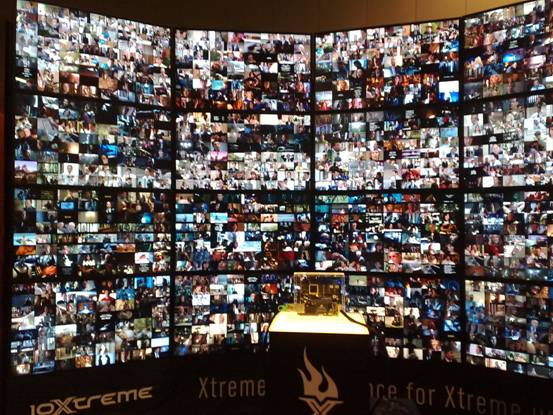 Fusion-io makes high speed solid state drives or SSDs. At SIGGRAPH 2009, Fusion-io announced a new line of ioXtreme workstation storage cards. Each ioXtreme card has an 80 gig capacity and screaming fast transfer speeds averaging around 520 MB/second. This is well suited for applications in film and television production, as well as for high-end gaming setups. Their booth at SIGGRAPH 2009 had a wall of LCD panels displays, simultaneously displaying 1200 DVD quality video streams from a single box.
Fusion-io makes high speed solid state drives or SSDs. At SIGGRAPH 2009, Fusion-io announced a new line of ioXtreme workstation storage cards. Each ioXtreme card has an 80 gig capacity and screaming fast transfer speeds averaging around 520 MB/second. This is well suited for applications in film and television production, as well as for high-end gaming setups. Their booth at SIGGRAPH 2009 had a wall of LCD panels displays, simultaneously displaying 1200 DVD quality video streams from a single box.
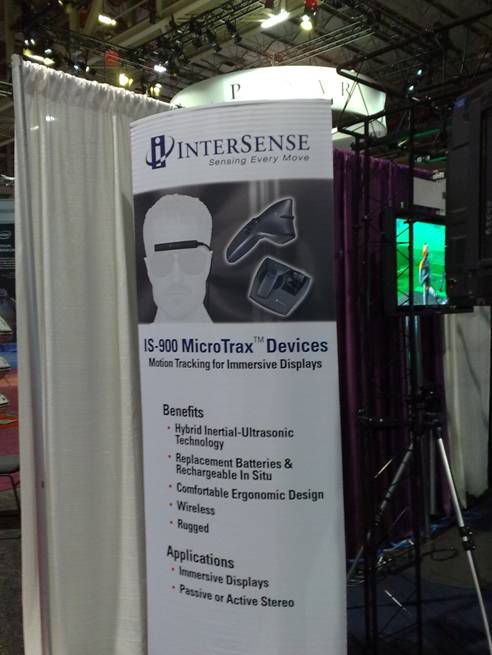 Intersense showcased its IS-900 MicroTrax product. This has 6 degrees of freedom wide area tracking features for "immersive displays, simulation & training, cockpit simulators, augmented & mixed reality, virtual prototyping and film/video production. Options include wireless, high precision and lightweight tracking sensors." Product literature points to application areas in fighter planes such as the F-16, car designs, in studies of human motion by sports researchers, visualization simulators in universities, and immersive entertainment showcases.
Intersense showcased its IS-900 MicroTrax product. This has 6 degrees of freedom wide area tracking features for "immersive displays, simulation & training, cockpit simulators, augmented & mixed reality, virtual prototyping and film/video production. Options include wireless, high precision and lightweight tracking sensors." Product literature points to application areas in fighter planes such as the F-16, car designs, in studies of human motion by sports researchers, visualization simulators in universities, and immersive entertainment showcases.
 I like counters. This live counter of NVIDIA CUDA GPU sales is a kick-ass challenge to competitors. NVIDIA GPUs are used increasingly for real-time rendering of interactive games with great visual details, as well as in compute-intensive tasks.
I like counters. This live counter of NVIDIA CUDA GPU sales is a kick-ass challenge to competitors. NVIDIA GPUs are used increasingly for real-time rendering of interactive games with great visual details, as well as in compute-intensive tasks.
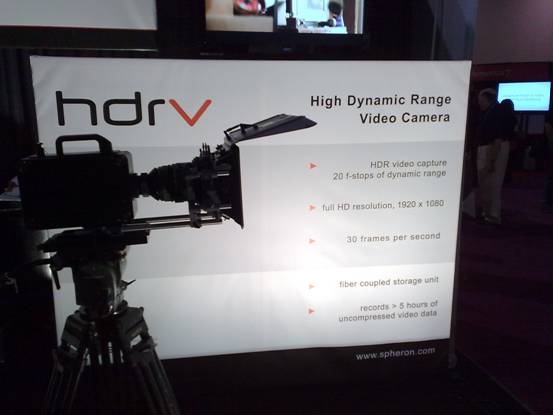 SPHERON-VR showcased a new high dynamic range video camera. This camera supports HDR video capture with 20 f-stops of dynamic range in full HD resolution (1920 x1080) at 30 frames per second. It has a fiber coupled storage unit which affords up to 5 hours of uncompressed video data. HDR images are incredibly detailed and clear. This amount of processing power is expensive.
SPHERON-VR showcased a new high dynamic range video camera. This camera supports HDR video capture with 20 f-stops of dynamic range in full HD resolution (1920 x1080) at 30 frames per second. It has a fiber coupled storage unit which affords up to 5 hours of uncompressed video data. HDR images are incredibly detailed and clear. This amount of processing power is expensive.
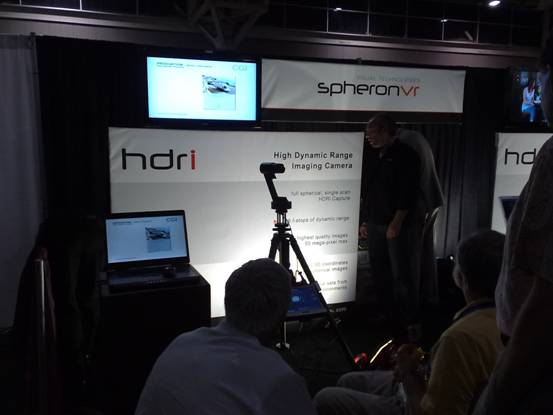 This is a SPHERON-VR HDR imaging camera. It supports full spherical single scan captures, with 26 f-stops in one scan, up-to 50 megapixel maximum, and is very portable.
This is a SPHERON-VR HDR imaging camera. It supports full spherical single scan captures, with 26 f-stops in one scan, up-to 50 megapixel maximum, and is very portable.
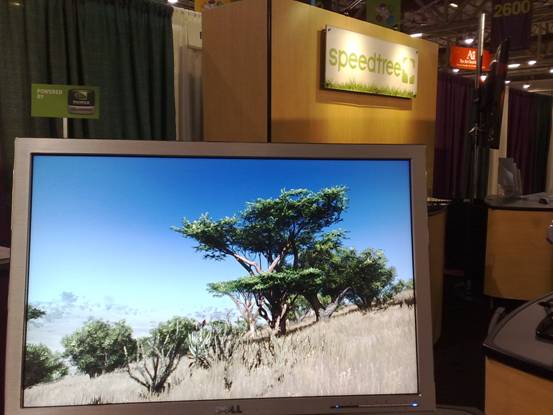 SpeedTree Cinema is foliage simulation software which offers extremely realistic simulations of objects such as the trees seen in the image capture above. Product literature highlights that Lucasfilm's Industrial Light & Magic division has licenses of SpeedTree Cinema use in its feature films.
SpeedTree Cinema is foliage simulation software which offers extremely realistic simulations of objects such as the trees seen in the image capture above. Product literature highlights that Lucasfilm's Industrial Light & Magic division has licenses of SpeedTree Cinema use in its feature films.
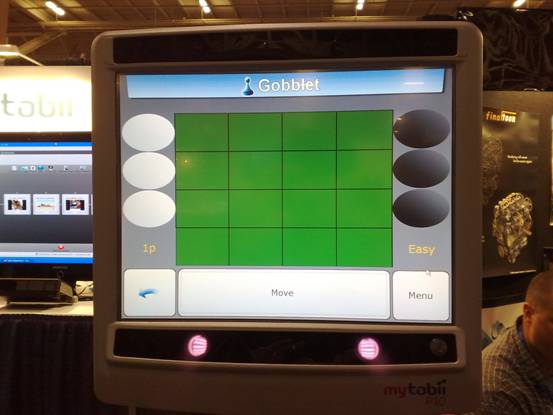 Tobii's eye tracker products and solutions track the user's eyes and use the position of the eye gaze as an input to indicate areas of interest on the screen. These solutions are used in market research, usability studies, in assistive applications, and in scientific research. Advertisers are interested in eyeballs; in the amount of time a pair of eyes (from a targeted customer) spends on a region of a marketing display. This data is collected and analysed to predict potential customer interests and improve sales. "Tobii solutions allow effective eye tracking testing on a wide range of different media such as print ads, TV commercials, product packaging, shopping shelves, as well as websites, software, computer games, newsletters, e-mail campaigns, interactive TV and mobile devices."
Tobii's eye tracker products and solutions track the user's eyes and use the position of the eye gaze as an input to indicate areas of interest on the screen. These solutions are used in market research, usability studies, in assistive applications, and in scientific research. Advertisers are interested in eyeballs; in the amount of time a pair of eyes (from a targeted customer) spends on a region of a marketing display. This data is collected and analysed to predict potential customer interests and improve sales. "Tobii solutions allow effective eye tracking testing on a wide range of different media such as print ads, TV commercials, product packaging, shopping shelves, as well as websites, software, computer games, newsletters, e-mail campaigns, interactive TV and mobile devices."
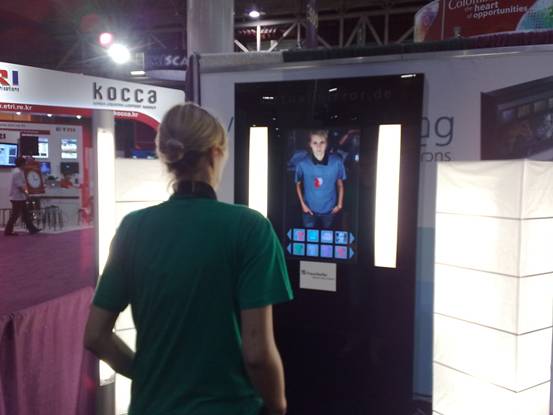 Fraunhofer, a major research organisation from Germany, has a booth demonstrating technologies such as the Virtual Mirror seen in the picture above. This is an augmented reality solution without the need for glasses. It combines real and virtual parts in one world and uses image processing and tracking techniques to create a real-time experience. The user stands in front of the mirror and sees images being superimposed on her clothing. In this case, the researcher revealed that she had to wear green (or a solid color) for the camera imaging system to do its magic.
Fraunhofer, a major research organisation from Germany, has a booth demonstrating technologies such as the Virtual Mirror seen in the picture above. This is an augmented reality solution without the need for glasses. It combines real and virtual parts in one world and uses image processing and tracking techniques to create a real-time experience. The user stands in front of the mirror and sees images being superimposed on her clothing. In this case, the researcher revealed that she had to wear green (or a solid color) for the camera imaging system to do its magic.
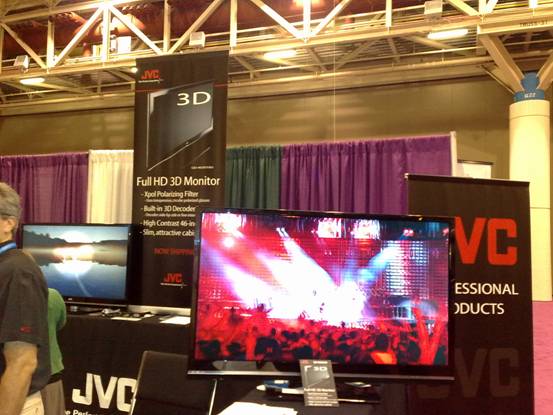 The JVC booth has a gorgeous and expensive-looking large full HD 3D LCD monitor for professional use on display. It is a 46-inch display, 1-1/2 inches (39mm) thin and "uses JVC's unique high-quality 3D visual engine to deliver a natural, flicker-free visual experience. Video input is compatible with industry standard line-by-line and side-by-side 3D formats".
The JVC booth has a gorgeous and expensive-looking large full HD 3D LCD monitor for professional use on display. It is a 46-inch display, 1-1/2 inches (39mm) thin and "uses JVC's unique high-quality 3D visual engine to deliver a natural, flicker-free visual experience. Video input is compatible with industry standard line-by-line and side-by-side 3D formats".
 UK company "The Pixel Farm" launched PFPIPE at SIGGRAPH 2009. This is a workflow enhancement tool designed to automate (as much as possible) the motion paths of moving objects within a video sequence.
UK company "The Pixel Farm" launched PFPIPE at SIGGRAPH 2009. This is a workflow enhancement tool designed to automate (as much as possible) the motion paths of moving objects within a video sequence.
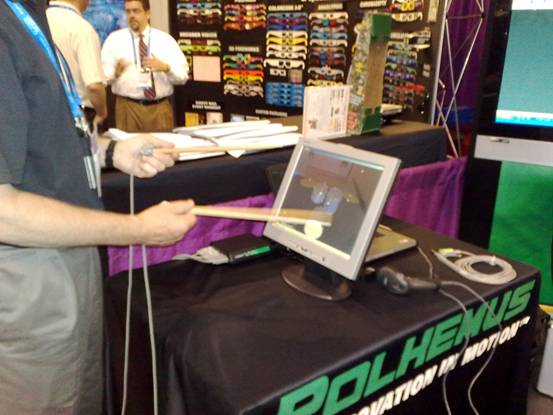 Polhemus is a technology company specialising in motion tracking. The drum demonstration above utilises 6-DOF sensors attached to each stick. This enables the sticks to be tracked accurately as the user beats into the air. The slightly visible bulge under the tablecloth is the magnetic base station which serves as the point of origin.
Polhemus is a technology company specialising in motion tracking. The drum demonstration above utilises 6-DOF sensors attached to each stick. This enables the sticks to be tracked accurately as the user beats into the air. The slightly visible bulge under the tablecloth is the magnetic base station which serves as the point of origin.
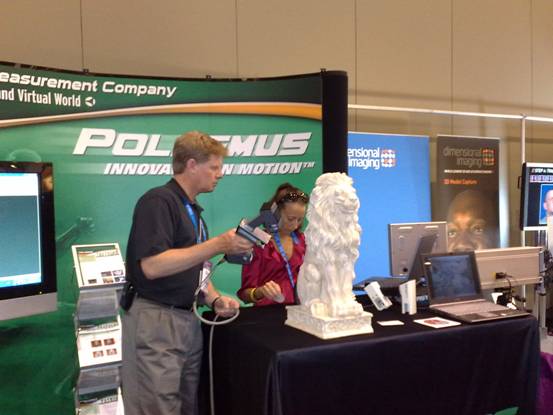 Above: demonstration of Polhemus 3D scanner being used live on the complicated contours of a lion sculpture.
Above: demonstration of Polhemus 3D scanner being used live on the complicated contours of a lion sculpture.
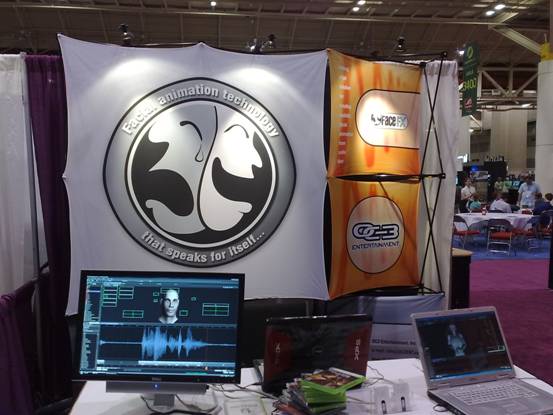 OC3 Entertainment demonstrated the FaceFX product. This is a solution for creating realistic facial animation from audio files. The system drives facial animation with audio input and currently supports 7 languages; Mandarin is not one of them, yet, according to the staff. FaceFX features lip-synchronization, 3D graphics, and facial animation. "The product makes it easy to batch process thousands of WAV files for your game, add expressions to a single animation without ruining the lip-synchronization, tweak an animation to perfection, or integrate the entire solution into the art pipeline".
OC3 Entertainment demonstrated the FaceFX product. This is a solution for creating realistic facial animation from audio files. The system drives facial animation with audio input and currently supports 7 languages; Mandarin is not one of them, yet, according to the staff. FaceFX features lip-synchronization, 3D graphics, and facial animation. "The product makes it easy to batch process thousands of WAV files for your game, add expressions to a single animation without ruining the lip-synchronization, tweak an animation to perfection, or integrate the entire solution into the art pipeline".
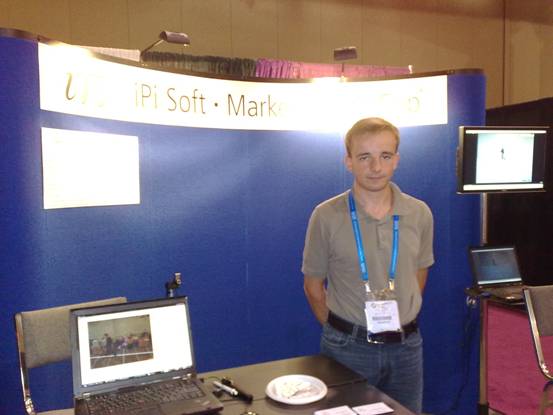 iPi Desktop Motion Capture is an entry-level marker-less motion capture technology. It uses 3 cameras to triangulate and compute positions. This use of ordinary webcams literally put the mocap option onto the desktop. The conversion to 3D is done offline to lower costs. The target customers are small studios, freelance animators and motion capture enthusiasts.
The exhibition lasted three days and attracted a respectable turnout. As economic stimulants begin to work their magic around the world, there are some hopeful expectations that the 2010 exhibition will be bigger and will draw a larger audience than this year's conference. Judging from the real-time rendering projects and integrated games content seen this year, perhaps next year's exhibition will also have more real-time entertainment product offerings. The exhibition attention also shifts to SIGGRAPH Asia 2009 in Yokohama, with anticipation of more interactive media exhibitors.
Tai Hou Tng
Writing on behalf of the Singapore ACM SIGGRAPH Chapter
taihou@gmail.com
iPi Desktop Motion Capture is an entry-level marker-less motion capture technology. It uses 3 cameras to triangulate and compute positions. This use of ordinary webcams literally put the mocap option onto the desktop. The conversion to 3D is done offline to lower costs. The target customers are small studios, freelance animators and motion capture enthusiasts.
The exhibition lasted three days and attracted a respectable turnout. As economic stimulants begin to work their magic around the world, there are some hopeful expectations that the 2010 exhibition will be bigger and will draw a larger audience than this year's conference. Judging from the real-time rendering projects and integrated games content seen this year, perhaps next year's exhibition will also have more real-time entertainment product offerings. The exhibition attention also shifts to SIGGRAPH Asia 2009 in Yokohama, with anticipation of more interactive media exhibitors.
Tai Hou Tng
Writing on behalf of the Singapore ACM SIGGRAPH Chapter
taihou@gmail.com
|

 Fusion-io makes high speed solid state drives or SSDs. At SIGGRAPH 2009, Fusion-io announced a new line of ioXtreme workstation storage cards. Each ioXtreme card has an 80 gig capacity and screaming fast transfer speeds averaging around 520 MB/second. This is well suited for applications in film and television production, as well as for high-end gaming setups. Their booth at SIGGRAPH 2009 had a wall of LCD panels displays, simultaneously displaying 1200 DVD quality video streams from a single box.
Fusion-io makes high speed solid state drives or SSDs. At SIGGRAPH 2009, Fusion-io announced a new line of ioXtreme workstation storage cards. Each ioXtreme card has an 80 gig capacity and screaming fast transfer speeds averaging around 520 MB/second. This is well suited for applications in film and television production, as well as for high-end gaming setups. Their booth at SIGGRAPH 2009 had a wall of LCD panels displays, simultaneously displaying 1200 DVD quality video streams from a single box.
 Intersense showcased its IS-900 MicroTrax product. This has 6 degrees of freedom wide area tracking features for "immersive displays, simulation & training, cockpit simulators, augmented & mixed reality, virtual prototyping and film/video production. Options include wireless, high precision and lightweight tracking sensors." Product literature points to application areas in fighter planes such as the F-16, car designs, in studies of human motion by sports researchers, visualization simulators in universities, and immersive entertainment showcases.
Intersense showcased its IS-900 MicroTrax product. This has 6 degrees of freedom wide area tracking features for "immersive displays, simulation & training, cockpit simulators, augmented & mixed reality, virtual prototyping and film/video production. Options include wireless, high precision and lightweight tracking sensors." Product literature points to application areas in fighter planes such as the F-16, car designs, in studies of human motion by sports researchers, visualization simulators in universities, and immersive entertainment showcases.
 I like counters. This live counter of NVIDIA CUDA GPU sales is a kick-ass challenge to competitors. NVIDIA GPUs are used increasingly for real-time rendering of interactive games with great visual details, as well as in compute-intensive tasks.
I like counters. This live counter of NVIDIA CUDA GPU sales is a kick-ass challenge to competitors. NVIDIA GPUs are used increasingly for real-time rendering of interactive games with great visual details, as well as in compute-intensive tasks.
 SPHERON-VR showcased a new high dynamic range video camera. This camera supports HDR video capture with 20 f-stops of dynamic range in full HD resolution (1920 x1080) at 30 frames per second. It has a fiber coupled storage unit which affords up to 5 hours of uncompressed video data. HDR images are incredibly detailed and clear. This amount of processing power is expensive.
SPHERON-VR showcased a new high dynamic range video camera. This camera supports HDR video capture with 20 f-stops of dynamic range in full HD resolution (1920 x1080) at 30 frames per second. It has a fiber coupled storage unit which affords up to 5 hours of uncompressed video data. HDR images are incredibly detailed and clear. This amount of processing power is expensive.
 This is a SPHERON-VR HDR imaging camera. It supports full spherical single scan captures, with 26 f-stops in one scan, up-to 50 megapixel maximum, and is very portable.
This is a SPHERON-VR HDR imaging camera. It supports full spherical single scan captures, with 26 f-stops in one scan, up-to 50 megapixel maximum, and is very portable.
 SpeedTree Cinema is foliage simulation software which offers extremely realistic simulations of objects such as the trees seen in the image capture above. Product literature highlights that Lucasfilm's Industrial Light & Magic division has licenses of SpeedTree Cinema use in its feature films.
SpeedTree Cinema is foliage simulation software which offers extremely realistic simulations of objects such as the trees seen in the image capture above. Product literature highlights that Lucasfilm's Industrial Light & Magic division has licenses of SpeedTree Cinema use in its feature films.
 Tobii's eye tracker products and solutions track the user's eyes and use the position of the eye gaze as an input to indicate areas of interest on the screen. These solutions are used in market research, usability studies, in assistive applications, and in scientific research. Advertisers are interested in eyeballs; in the amount of time a pair of eyes (from a targeted customer) spends on a region of a marketing display. This data is collected and analysed to predict potential customer interests and improve sales. "Tobii solutions allow effective eye tracking testing on a wide range of different media such as print ads, TV commercials, product packaging, shopping shelves, as well as websites, software, computer games, newsletters, e-mail campaigns, interactive TV and mobile devices."
Tobii's eye tracker products and solutions track the user's eyes and use the position of the eye gaze as an input to indicate areas of interest on the screen. These solutions are used in market research, usability studies, in assistive applications, and in scientific research. Advertisers are interested in eyeballs; in the amount of time a pair of eyes (from a targeted customer) spends on a region of a marketing display. This data is collected and analysed to predict potential customer interests and improve sales. "Tobii solutions allow effective eye tracking testing on a wide range of different media such as print ads, TV commercials, product packaging, shopping shelves, as well as websites, software, computer games, newsletters, e-mail campaigns, interactive TV and mobile devices."
 Fraunhofer, a major research organisation from Germany, has a booth demonstrating technologies such as the Virtual Mirror seen in the picture above. This is an augmented reality solution without the need for glasses. It combines real and virtual parts in one world and uses image processing and tracking techniques to create a real-time experience. The user stands in front of the mirror and sees images being superimposed on her clothing. In this case, the researcher revealed that she had to wear green (or a solid color) for the camera imaging system to do its magic.
Fraunhofer, a major research organisation from Germany, has a booth demonstrating technologies such as the Virtual Mirror seen in the picture above. This is an augmented reality solution without the need for glasses. It combines real and virtual parts in one world and uses image processing and tracking techniques to create a real-time experience. The user stands in front of the mirror and sees images being superimposed on her clothing. In this case, the researcher revealed that she had to wear green (or a solid color) for the camera imaging system to do its magic.
 The JVC booth has a gorgeous and expensive-looking large full HD 3D LCD monitor for professional use on display. It is a 46-inch display, 1-1/2 inches (39mm) thin and "uses JVC's unique high-quality 3D visual engine to deliver a natural, flicker-free visual experience. Video input is compatible with industry standard line-by-line and side-by-side 3D formats".
The JVC booth has a gorgeous and expensive-looking large full HD 3D LCD monitor for professional use on display. It is a 46-inch display, 1-1/2 inches (39mm) thin and "uses JVC's unique high-quality 3D visual engine to deliver a natural, flicker-free visual experience. Video input is compatible with industry standard line-by-line and side-by-side 3D formats".
 UK company "The Pixel Farm" launched PFPIPE at SIGGRAPH 2009. This is a workflow enhancement tool designed to automate (as much as possible) the motion paths of moving objects within a video sequence.
UK company "The Pixel Farm" launched PFPIPE at SIGGRAPH 2009. This is a workflow enhancement tool designed to automate (as much as possible) the motion paths of moving objects within a video sequence.
 Polhemus is a technology company specialising in motion tracking. The drum demonstration above utilises 6-DOF sensors attached to each stick. This enables the sticks to be tracked accurately as the user beats into the air. The slightly visible bulge under the tablecloth is the magnetic base station which serves as the point of origin.
Polhemus is a technology company specialising in motion tracking. The drum demonstration above utilises 6-DOF sensors attached to each stick. This enables the sticks to be tracked accurately as the user beats into the air. The slightly visible bulge under the tablecloth is the magnetic base station which serves as the point of origin.
 Above: demonstration of Polhemus 3D scanner being used live on the complicated contours of a lion sculpture.
Above: demonstration of Polhemus 3D scanner being used live on the complicated contours of a lion sculpture.
 OC3 Entertainment demonstrated the FaceFX product. This is a solution for creating realistic facial animation from audio files. The system drives facial animation with audio input and currently supports 7 languages; Mandarin is not one of them, yet, according to the staff. FaceFX features lip-synchronization, 3D graphics, and facial animation. "The product makes it easy to batch process thousands of WAV files for your game, add expressions to a single animation without ruining the lip-synchronization, tweak an animation to perfection, or integrate the entire solution into the art pipeline".
OC3 Entertainment demonstrated the FaceFX product. This is a solution for creating realistic facial animation from audio files. The system drives facial animation with audio input and currently supports 7 languages; Mandarin is not one of them, yet, according to the staff. FaceFX features lip-synchronization, 3D graphics, and facial animation. "The product makes it easy to batch process thousands of WAV files for your game, add expressions to a single animation without ruining the lip-synchronization, tweak an animation to perfection, or integrate the entire solution into the art pipeline".
 iPi Desktop Motion Capture is an entry-level marker-less motion capture technology. It uses 3 cameras to triangulate and compute positions. This use of ordinary webcams literally put the mocap option onto the desktop. The conversion to 3D is done offline to lower costs. The target customers are small studios, freelance animators and motion capture enthusiasts.
The exhibition lasted three days and attracted a respectable turnout. As economic stimulants begin to work their magic around the world, there are some hopeful expectations that the 2010 exhibition will be bigger and will draw a larger audience than this year's conference. Judging from the real-time rendering projects and integrated games content seen this year, perhaps next year's exhibition will also have more real-time entertainment product offerings. The exhibition attention also shifts to SIGGRAPH Asia 2009 in Yokohama, with anticipation of more interactive media exhibitors.
Tai Hou Tng
Writing on behalf of the Singapore ACM SIGGRAPH Chapter
taihou@gmail.com
iPi Desktop Motion Capture is an entry-level marker-less motion capture technology. It uses 3 cameras to triangulate and compute positions. This use of ordinary webcams literally put the mocap option onto the desktop. The conversion to 3D is done offline to lower costs. The target customers are small studios, freelance animators and motion capture enthusiasts.
The exhibition lasted three days and attracted a respectable turnout. As economic stimulants begin to work their magic around the world, there are some hopeful expectations that the 2010 exhibition will be bigger and will draw a larger audience than this year's conference. Judging from the real-time rendering projects and integrated games content seen this year, perhaps next year's exhibition will also have more real-time entertainment product offerings. The exhibition attention also shifts to SIGGRAPH Asia 2009 in Yokohama, with anticipation of more interactive media exhibitors.
Tai Hou Tng
Writing on behalf of the Singapore ACM SIGGRAPH Chapter
taihou@gmail.com